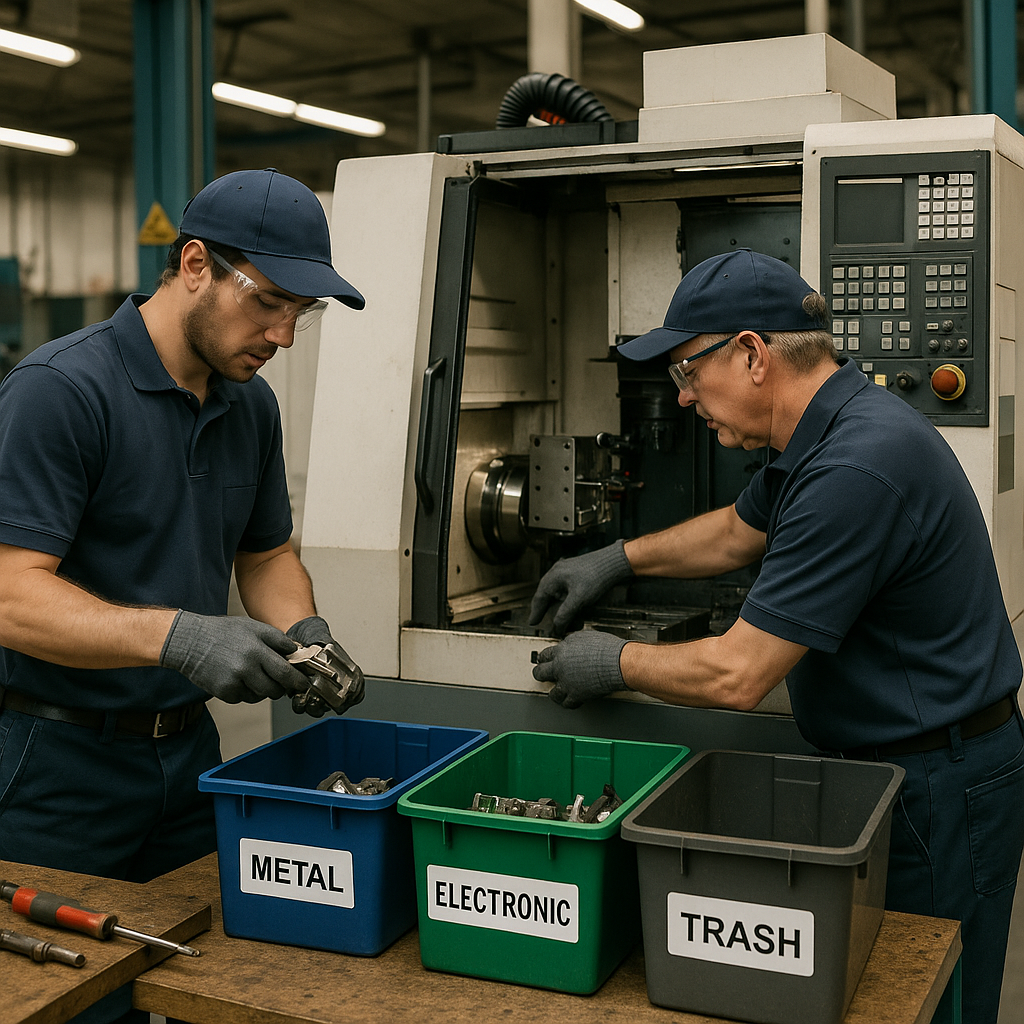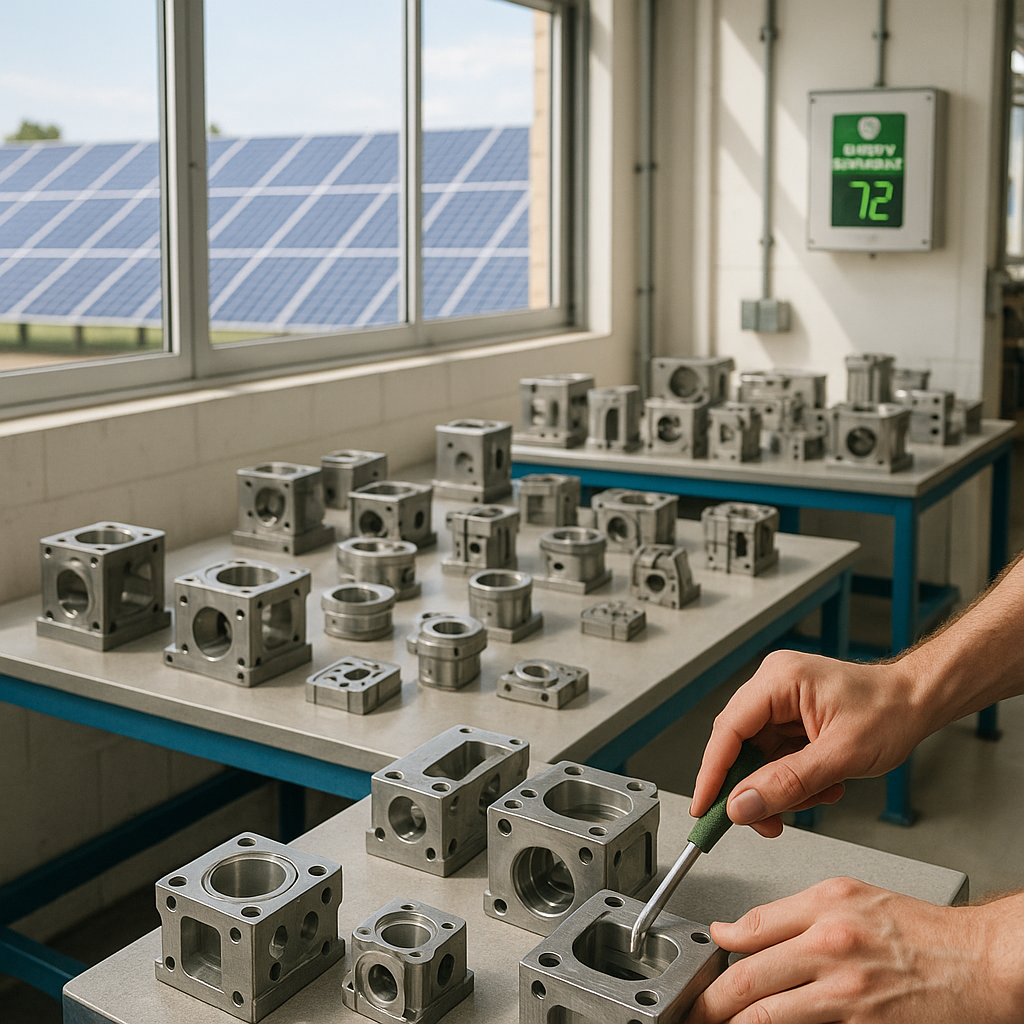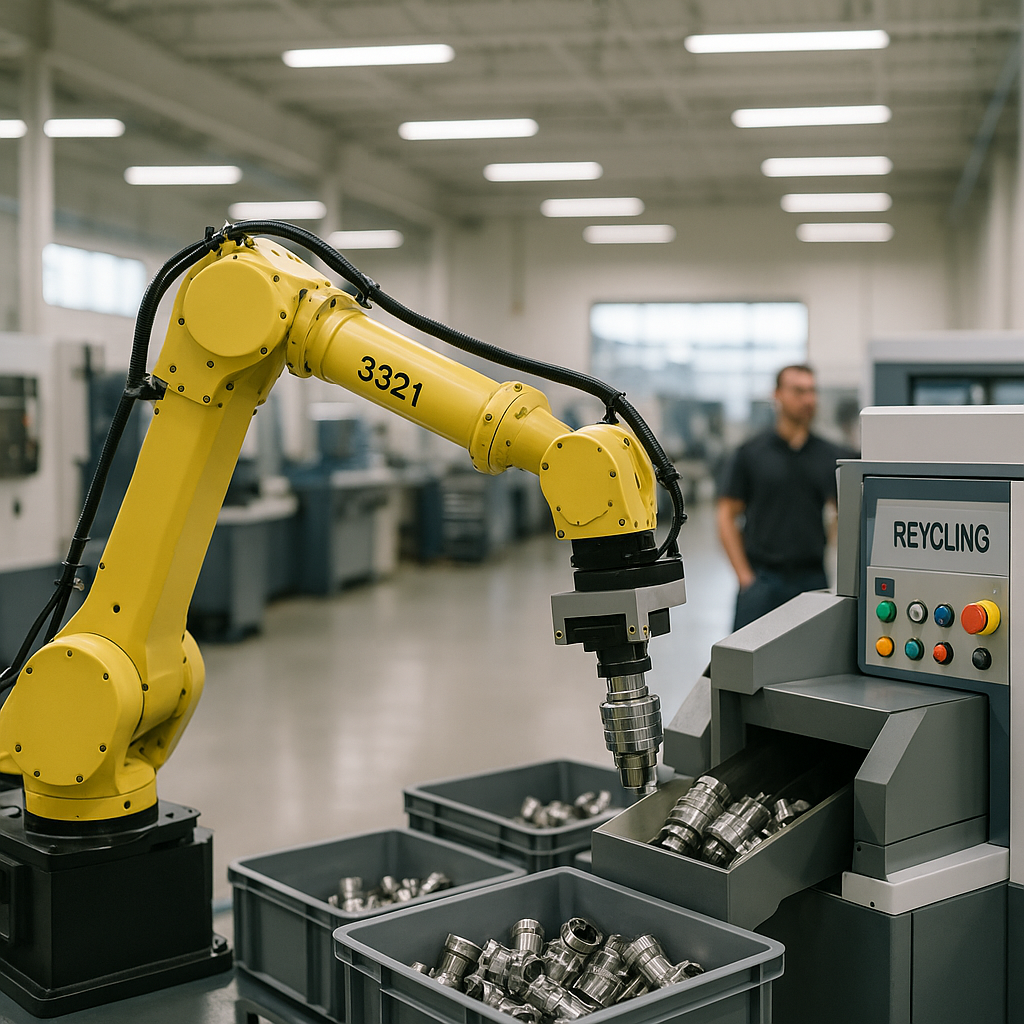5901 Botham Jean Blvd, Dallas, TX 75215
Benefits of Recycling Old CNC Machines and Lathes
July 26, 2025Every year, thousands of CNC machines and lathes reach the end of their primary service life, contributing to the growing crisis of electronic waste. Recycling these valuable industrial equipment pieces offers a sustainable alternative with significant benefits for both businesses and the environment.
CNC machines and lathes contain numerous valuable components, from motors and circuit boards to metal casings and precision parts. When properly recycled, these materials avoid landfills and instead find new purposes, extending benefits into economic and environmental realms beyond simple waste reduction.
Recycling industrial machinery effectively supports the circular economy by keeping valuable resources in use for as long as possible. This approach signifies a vital shift from traditional linear manufacturing models to more sustainable practices that benefit both industry and planet.
What are the Main Methods for Recycling CNC Machines?

Computer Numerical Control (CNC) machines and lathes remain valuable even at the end of their operational life. Responsible recycling of these sophisticated tools preserves resources and reduces environmental impact. Several proven methods exist for recycling these machines, each with specific applications and benefits.
Refurbishment and Reuse
Refurbishment is one of the most effective strategies for extending CNC machine lifespans. This process involves several key steps:
First, technicians thoroughly assess the machine’s condition. They identify worn parts for replacement, and control systems often receive software upgrades to enhance performance and add modern functionality. Mechanical components undergo cleaning, lubrication, and calibration to restore precision.
Refurbished machines provide excellent value for smaller manufacturing operations, delivering near-original performance at a fraction of the cost of new equipment. This approach also conserves the substantial resources required for manufacturing new machines.
Component Extraction and Reprocessing
When machines reach the end of their functional life, valuable components can be recovered through systematic disassembly:
Motors and drive systems often retain significant value for reuse in other equipment. Circuit boards and electronic controls contain precious metals like gold, silver, and copper that specialized facilities can extract. Precision components such as bearings, ballscrews, and linear guides may be refurbished for use as replacement parts.
This targeted approach preserves the highest value elements of the machine, creating a supply of replacement parts that keeps other machines operational longer.
Metal Recycling
The structural elements of CNC machines are primarily made of various metals that can be efficiently recycled:
Cast iron components from machine bases and frames provide high-quality recyclable material. Steel elements from structural supports and covers enter standard recycling streams. Aluminum components, often found in housings and some structural elements, are particularly valuable in recycling markets.
These materials undergo sorting, cleaning, and processing at metal recycling facilities. They return to the manufacturing supply chain as raw materials for new products, conserving the energy and resources required for virgin metal production.
Waste Repurposing
Beyond the machines themselves, the manufacturing waste they produce offers recycling opportunities:
Metal shavings and turnings, known as swarf, accumulate during machining operations. Rather than discarding these materials, innovative approaches incorporate them into other products. For example, steel swarf can strengthen concrete when used as a reinforcing material.
Cutting fluids and coolants undergo filtration and treatment for reuse, reducing both waste and the need for new fluid production. Metal dust from grinding operations can serve as raw material for powder metallurgy processes.
Case Study: Industrial Swarf Recycling Success
A manufacturing facility in Houston implemented a comprehensive CNC waste management program with impressive results. The company previously sent approximately 1,200 pounds of metal shavings to general scrap recycling monthly.
By partnering with a specialized metal recycler, they began separating aluminum, steel, and copper swarf into dedicated collection systems. The separated materials now command premium prices in recycling markets. Additionally, they incorporated steel swarf into concrete manufacturing as reinforcing fibers.
This program reduced their waste disposal costs by 35% while generating new revenue streams. The concrete applications prevented 462 MJ of fossil fuel consumption per cubic meter by replacing commercial steel fibers with recycled material.
These combined approaches demonstrate how comprehensive CNC recycling programs deliver both environmental and economic benefits. The metals maintain their intrinsic value while reducing the energy consumption and emissions associated with producing new materials.
What are the Environmental Impacts of CNC Recycling?

CNC machine recycling offers substantial environmental benefits on several fronts. Firstly, it significantly reduces e-waste in landfills. CNC machines contain hazardous materials like lead, cadmium, and mercury that can leach into soil and water when improperly discarded. By recycling these machines, we prevent these harmful substances from contaminating ecosystems.
The energy conservation aspect of CNC recycling is noteworthy. Manufacturing new CNC machines requires significant energy for raw material extraction, processing, and assembly. Recycling conserves up to 70% of the energy required to produce new machines from virgin materials. This energy reduction directly translates to lower greenhouse gas emissions across the manufacturing lifecycle.
Material conservation is another critical environmental benefit. Recycling CNC machines allows valuable metals like aluminum, steel, and titanium to be recovered and reprocessed. These materials reenter production cycles without necessitating new mining operations, significantly reducing the environmental impact associated with resource extraction.
Quantifiable Environmental Benefits
The environmental impact of CNC recycling becomes clearer when examining specific metrics. For example, using lathe waste as concrete reinforcement can reduce CO2 emissions by 14% compared to using virgin materials, thereby significantly lowering the carbon footprint for construction projects that incorporate recycled CNC waste.
CNC recycling also supports water conservation efforts. Traditional manufacturing requires substantial water for cooling and lubrication. By implementing closed-loop cooling systems and recycling methods within CNC operations, manufacturers can reduce water consumption by up to 80%, significantly lessening the strain on local water supplies.
E-waste reduction through CNC recycling has immediate environmental implications. The EPA estimates that recycling one million laptops saves enough energy to power over 3,500 homes for a year. While CNC machines differ in composition, their recycling follows similar principles and yields comparable energy savings relative to their size and material content.
Challenges and Considerations
Despite these benefits, the recycling process requires energy and can produce emissions. Transporting, disassembling, and processing CNC machines demands resources, complicating the environmental equation when weighing these costs against the benefits of recycling.
Life cycle assessments show that optimizing recycling methods is crucial for maximizing environmental benefits. For instance, localized recycling facilities reduce transportation emissions. Advanced separation techniques enhance material recovery rates, and energy-efficient recycling equipment minimizes the carbon footprint of the recycling process itself.
Material composition also affects recyclability. Modern CNC machines often contain composite materials that pose recycling challenges. However, manufacturers increasingly design machines with end-of-life considerations, making future generations of CNC equipment more recyclable.
The comprehensive environmental benefits of CNC recycling become most apparent when considering the full lifecycle impact. From reduced mining operations to decreased landfill usage, the cumulative effect represents significant ecological preservation. As recycling technologies advance, we can expect even greater environmental benefits from CNC recycling initiatives.
What are the Challenges in CNC Machine Recycling?
Recycling CNC machines involves several complex challenges affecting the entire process from collection to reuse. These sophisticated manufacturing tools contain multiple materials and components that require specialized handling.
Material Separation Complexity
CNC machines comprise a diverse mix of materials, including metals, plastics, glass, and composites. Effectively separating these materials is challenging. The intricate design of CNC equipment often results in tightly integrated components, making disassembly labor-intensive and technically demanding.
Modern CNC machines contain specialized alloys and proprietary components, further complicating the separation process. Without proper sorting, the value of recovered materials decreases substantially, reducing recycling efforts’ economic viability.
Materials like circuit boards contain small amounts of precious metals that require specialized processes for efficient recovery. Sometimes, the cost of precision separation exceeds the value of the recovered materials.
Hazardous Materials Management
CNC machines often contain components with hazardous substances that require careful handling during the recycling process. These include lead in solder joints, mercury in switches, cadmium in circuit boards, and various coolants and lubricants that can be toxic if improperly managed.
Recyclers must comply with strict regulations governing hazardous material handling, requiring specialized training, equipment, and facilities, which add to the overall cost of recycling.
Improper handling of these substances can lead to soil and water contamination, creating environmental liabilities that extend beyond the recycling facility. This risk factor deters some potential recyclers from entering the market.
Energy Consumption and Emissions
The recycling process requires significant energy inputs and can generate emissions. Transportation, disassembly, material processing, and refurbishment all consume energy and potentially produce carbon emissions.
Crushing, shredding, and melting metals for recovery are energy-intensive processes. The environmental benefit of recycling must be weighed against these energy costs to determine the net positive impact.
Water usage in cleaning components and cooling recycling equipment is another environmental consideration. Closed-loop systems can reduce water consumption but add complexity to recycling operations.
Logistical Hurdles
CNC machines are large, heavy pieces of industrial equipment posing significant logistical challenges. Their size and weight make transportation expensive and complicated, requiring specialized equipment and handling.
Collection networks for industrial machinery are less developed compared to consumer electronics or household items, creating gaps in recycling infrastructure that impede efficient collection.
Many manufacturing facilities are located in industrial areas, often distant from recycling centers, increasing transportation costs and associated emissions. Coordination between decommissioning, collection, and processing requires careful planning.
Market Uncertainties
The market for recycled materials and refurbished CNC machines fluctuates based on economic conditions, technological advancements, and industry demand, making investment in recycling infrastructure risky.
Newer CNC machine models with advanced features often make older refurbished models less attractive to buyers, reducing the resale value of recycled machines.
Competition from low-cost new equipment manufactured overseas can undercut the market for refurbished machines, putting pressure on recyclers who invest in proper material recovery.
Emerging Solutions and Innovations
Despite these challenges, innovative companies are developing solutions to make CNC machine recycling more viable. Advanced sorting technologies using artificial intelligence and machine learning are improving material separation efficiency, allowing materials to be identified and sorted faster and more accurately than manual methods.
Some manufacturers are adopting design-for-disassembly principles, making newer machines easier to recycle at end-of-life. This forward-thinking approach addresses recycling challenges at the design stage rather than after disposal.
Regional recycling hubs are emerging to address logistical challenges by providing centralized facilities for collection and processing. These hubs create economies of scale that enhance the economics of CNC machine recycling.
The development of specialized tools and processes for handling hazardous materials is making compliance with regulations more cost-effective, reducing barriers to entry for recyclers and improving safety throughout the recycling chain.
By transforming these challenges into opportunities for innovation, the recycling industry continues to develop more efficient and economical approaches to CNC machine recycling. These advancements are crucial for creating a truly circular economy in manufacturing technology.
Conclusion: The Future of CNC Machine Recycling

As sustainability gains importance in manufacturing, CNC machine recycling will be essential for reducing waste and conserving resources. The CNC industry is at a critical juncture where environmental responsibility is crucial for long-term viability. Despite current challenges, the future holds great promise through innovative approaches that turn what was once considered waste into valuable resources.
The increased focus on circular economy principles within CNC manufacturing is driving new solutions, such as incorporating machine waste into new products, developing advanced recycling techniques for electronic components, and implementing energy recovery systems. By adopting these recycling and sustainable manufacturing practices, the CNC industry can significantly reduce its environmental impact while creating new economic opportunities. The collective impact of individual companies adopting sustainable practices will transform the entire manufacturing sector, leading to a more resource-efficient future.
If your business uses CNC equipment, now is the time to evaluate your recycling options. Consider contacting Okon Recycling at 214-717-4083 for specialized CNC recycling solutions that can help your organization contribute to a more sustainable manufacturing ecosystem.
